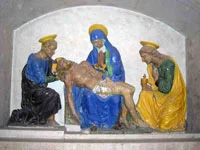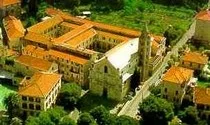The Pietà
Documents
3.THE PIETA OR LAMENTATION OVER THE BODY OF CHRIST (1530-1533)
located in the second Cloister
(click on the photos)
 Of the three majolica specimens of the Scuola robbiana (first half of the 16th century), which are preserved in the abbey of Finalpia (Savona), the one with the highest artistic level is PIETÀ, the work of Santi Buglioni (1494-1576), a Tuscan sculptor very well known and repeatedly mentioned in the Treccani Encyclopedia.
Of the three majolica specimens of the Scuola robbiana (first half of the 16th century), which are preserved in the abbey of Finalpia (Savona), the one with the highest artistic level is PIETÀ, the work of Santi Buglioni (1494-1576), a Tuscan sculptor very well known and repeatedly mentioned in the Treccani Encyclopedia.This fact is already remarkable given that the other two specimens are the work of anonymous (although they are usually attributed to the workshop of Giovanni della Robbia).
But the differences between the "Pietà" and the two specimens mentioned above do not stop here.
While in fact in the other two groups characters are embedded in the wall, in this "Pietà", the figures are all round and wrapped in a dynamism that is completely absent in the others.
On the other hand, unlike the other specimens, the "Pietà" is devoid of decorative elements (vegetable festoons, heraldic coats of arms).
Furthermore, in "piety" the shine of the majolica is reserved for the drapery while the human body, dark and opaque, is devoid of it. This detail is due to a special search for realism that suggests to the artist - inspired, as regards the composition, to the "Vatican Pietà by Michelangelo" - to give greater emphasis to the anatomical factor, as is apparent from the three-quarter twist of the bust of Christ, with half-closed eyelids, bloodless left hand and dead right arm. With this work it can be said that the Della Robbia school produced its latest masterpiece.
Let's try to examine this group more closely to find out some details:
not with the eye of the art critic,
but rather with that of the heart.
On the right, with the gesture of bringing her left hand to her breast, Mary of Magdala expresses all her dismay at the corpse of the Rabbi of Nazareth who had read them in her heart, had freed her from the chains that tied her to a sad past and he had forgiven her all ...The jar of some ointment, which she holds in her right hand, tastes a little pathetic, in the face of the destruction of that corpse. It almost seems that this Mary, anxious to do something more for Jesus, at the last moment took what she had at hand, without considering the inadequacy of what she was doing.Nicodemus, a more practical man, will carry thirty kilos of a mixture of myrrh and aloe, for that purpose.




